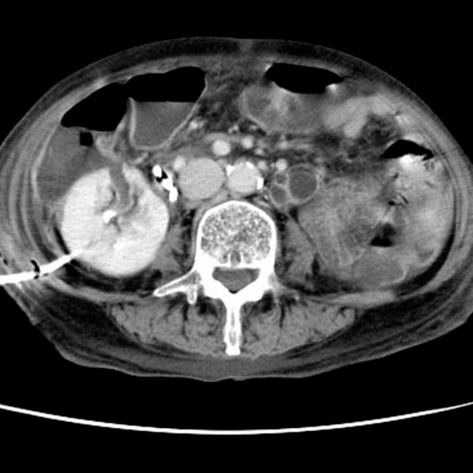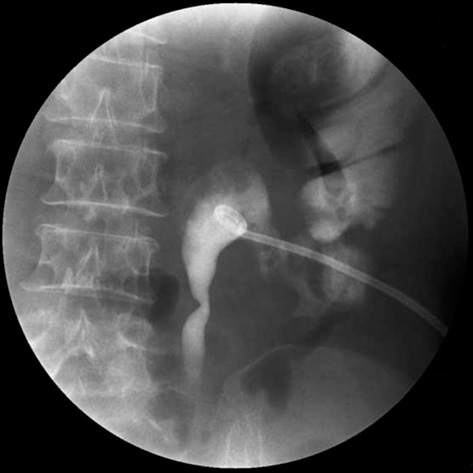J Korean Med Sci.
2009 Oct;24(5):960-962. 10.3346/jkms.2009.24.5.960.
Renocolic Fistula Secondary to a Perinephric Abscess: A Late Complication of a Forgotten Double J Stent
- Affiliations
-
- 1Department of Urology, Kangwon National University College of Medicine and Clinical Research Institute of Kangwon National University Hospital, Chunchon, Korea. paulee@kangwon.ac.kr
- KMID: 1782023
- DOI: http://doi.org/10.3346/jkms.2009.24.5.960
Abstract
- Late complications of ureteral stents are frequent, and longer indwelling times are associated with an increased frequency of complications. Although there are reports of various complications of long-term indwelling ureteral stents, a renocolic fistula secondary to a perinephric abscess resulting from an indwelling ureteral stent has not been reported. Here, we present a fatal case of a renocolic fistula secondary to a perinephric abscess caused by an encrusted forgotten double J stent in a functionally solitary kidney.
MeSH Terms
-
Abscess/*complications
Aged
Colonic Diseases/diagnosis/*etiology
Female
Foreign-Body Migration/complications
Humans
Intestinal Fistula/diagnosis/*etiology
Kidney/ultrasonography
Kidney Diseases/complications/diagnosis/*etiology
Kidney Failure/etiology
Sepsis/etiology
Stents/*adverse effects
Tomography, X-Ray Computed
Ureteral Obstruction/diagnosis
Urinary Fistula/diagnosis/*etiology
Figure
Reference
-
1. Richter S, Ringel A, Shalev M, Nissenkorn I. The indwelling ureteric stent: a 'friendly' procedure with unfriendly high morbidity. BJU Int. 2000. 85:408–411.
Article2. Paick SH, Park HK, Oh SJ, Kim HH, Kim SW. Characteristics of bacterial colonization and urinary tract infection after double-J ureteral stent indwelling. Korean J Urol. 2002. 43:291–295.3. Damiano R, Oliva A, Esposito C, De Sio M, Autorino R, D'Armiento M. Early and late complications of double pigtail ureteral stent. Urol Int. 2002. 69:136–140.
Article4. Singh V, Srinivastava A, Kapoor R, Kumar A. Can the complicated forgotten indwelling ureteric stents be lethal? Int Urol Nephrol. 2005. 37:541–546.
Article5. Chung SY, Stein RJ, Landsittel D, Davies BJ, Cuellar DC, Hrebinko RL, Tarin T, Averch TD. 15-year experience with the management of extrinsic ureteral obstruction with indwelling ureteral stents. J Urol. 2004. 172:592–595.
Article6. Lynch MF, Ghani KR, Frost I, Anson KM. Preventing the forgotten ureteral stent: implementation of a web-based stent registry with automatic recall application. Urology. 2007. 70:423–426.
Article




